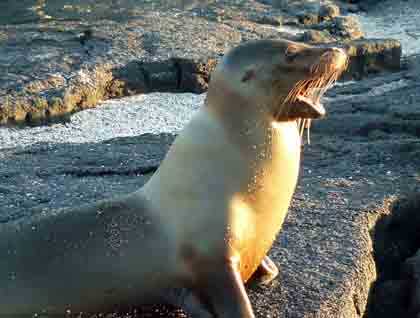The youngest islands of the archipelago, Fernandina and Isabela, are unique due to their active volcanoes, great endemism, and beautiful landscapes unlike anywhere else in the world.
After a long navigation from Rabida and after crossing the equator, early in the morning we reached the northern side of Isabela. The ocean was calm and there was a pleasant breeze coming from the southeast as we approached the gigantic volcano which was colored with the first beams of the sun. The National Geographic Islander navigated along the coastline allowing us to enjoy the incredible geology, while some others spotted some sea birds skimming the surface for planktonic species. We had a big surprise that the ocean prepared for us, dozens of common dolphins swam and jumped trying to get our attention. Of course they captivated us, but not only due to their beauty, but also for their tameness which was possible to observe at their close distance.
After breakfast we crossed the line of the equator and after a small ceremony to commemorate the crossing, we soon arrived at Punta Vicente Roca (the northern part of Isabela) and had a Zodiac ride. We were able to spot a group of flightless cormorants fishing and surfacing around our Zodiac and also Galapagos penguins and some brown noddy terns nesting along the vertical cliffs. In the ocean we spied green sea turtles floating on the surface just resting and basking. Back onboard we prepared our wetsuits and decided to snorkel around the same bay we visited on our Zodiac ride. This time the cormorants got a bit closer to us underwater making it possible to see their powerful webbed feet and then, like torpedoes, they disappeared swimming straight to the depths of the ocean. We encountered some green sea turtles resting on the sandy bottom while others were feeding on the green algae off the shallow rocky shore.
After lunch and shore navigation, the National Geographic Islander was repositioned and anchored off the coast of the youngest island of Fernandina, arriving to Punta Espinoza (or spiny point due to sharp lava found everywhere there). As soon as we had a dry landing we found hundreds of large marine iguanas welcoming us to enter the most pristine island in the archipelago. Baby Galapagos sea lions rested on the blackish sandy beach while others slept as lava lizards walked on their bodies trying to catch some tiresome flies. Walking along the seashore we arrived at the flightless cormorant area, observing how they dried their stumpy wings, and just behind of them marine iguanas sneezed salt out of their nostrils, producing an unmistakable noise.
With the last beams of sun, we returned back onboard, observing an incredible sunset with the best memories of this incredible place called Galapagos.







